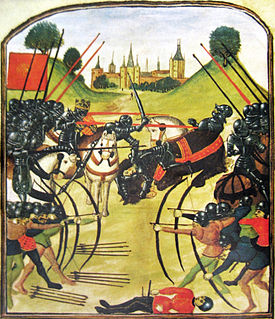 W
WThe Battle of Barnet was a decisive engagement in the Wars of the Roses, a dynastic conflict of 15th-century England. The military action, along with the subsequent Battle of Tewkesbury, secured the throne for Edward IV. On 14 April 1471 near Barnet, then a small Hertfordshire town north of London, Edward led the House of York in a fight against the House of Lancaster, which backed Henry VI for the throne. Leading the Lancastrian army was Richard Neville, Earl of Warwick, who played a crucial role in the fate of each king. Historians regard the battle as one of the most important clashes in the Wars of the Roses, since it brought about a decisive turn in the fortunes of the two houses. Edward's victory was followed by 14 years of Yorkist rule over England.
 W
WThe Battle of Blore Heath was a battle in the English Wars of the Roses. It was fought on 23 September 1459, at Blore Heath in Staffordshire. Blore Heath is a sparsely populated area of farmland, two miles east of the town of Market Drayton in Shropshire, and close to the towns of Market Drayton and Loggerheads, Staffordshire.
 W
WThe Battle of Bosworth Field was the last significant battle of the Wars of the Roses, the civil war between the Houses of Lancaster and York that extended across England in the latter half of the 15th century. Fought on 22 August 1485, the battle was won by the Lancastrians. Their leader Henry Tudor, Earl of Richmond, became the first English monarch of the Tudor dynasty by his victory and subsequent marriage to a Yorkist princess. His opponent Richard III, the last king of the House of York, was killed during the battle, the last English monarch to die in combat. Historians consider Bosworth Field to mark the end of the Plantagenet dynasty, making it one of the defining moments of English history.
 W
WThe Battle of Edgecote took place on 26 July 1469, during the Wars of the Roses. It was fought between a Royal army, commanded by the earls of Pembroke and Devon, and a rebel force led by supporters of the Earl of Warwick.
 W
WThe Battle of Ferrybridge, 28 March 1461, was a preliminary engagement between the houses of York and Lancaster before the larger battle of Towton, during the period now known as the Wars of the Roses.
 W
WThe Battle of Hedgeley Moor, 25 April 1464, was a battle of the Wars of the Roses. It was fought at Hedgeley Moor, north of the villages of Glanton and Powburn in Northumberland, between a Yorkist army led by John Neville, Lord Montagu and a Lancastrian army led by Henry Beaufort, Duke of Somerset. The battle ended in a Yorkist victory.
 W
WThe Battle of Hexham marked the end of significant Lancastrian resistance in the north of England during the early part of the reign of Edward IV.
 W
WThe Battle of Losecoat Field was fought on 12 March 1470, during the Wars of the Roses. Spellings of "Losecoat" vary, with "Losecote" and "Loose-coat" also seen.
 W
WThe Battle of Ludford Bridge was a largely bloodless confrontation fought in the early years of the Wars of the Roses. It took place on 12 October 1459, and resulted in a setback for the Yorkists. Although this seemed to be a triumph for the rival Lancastrians at the time, they had thrown away their advantage within six months.
 W
WThe Battle of Mortimer's Cross was fought on 2 February 1461 near Wigmore, Herefordshire, not far from the Welsh border. It was a major battle of the Wars of the Roses. The opposing forces were an army led by Jasper Tudor and his father, Owen Tudor, and other nobles loyal to King Henry VI of the House of Lancaster, his wife, Margaret of Anjou, and their seven-year-old son, Edward, Prince of Wales, on one side, and the army of Edward, Earl of March. Some sources say it was fought on 3 February, and the exact location has been the subject of some speculation.
 W
WThe Battle of Northampton was fought on 10 July 1460 near the River Nene, Northamptonshire. It was a major battle of the Wars of the Roses. The opposing forces were an army led by nobles loyal to King Henry VI of the House of Lancaster, his Queen Margaret of Anjou and their seven-year-old son Edward, Prince of Wales on one side, and the army of Edward, Earl of March and Warwick the Kingmaker on the other. The battle was the first in which artillery was used in England.
 W
WThe Battle of Sandwich was a naval skirmish off the town of Sandwich on the 15 January 1460 during the Wars of the Roses. In it, Sir John Dynham and the Earl of Warwick, Captain of Calais, on the Yorkist side, defeated a Lancastrian fleet and captured several of its ships. Little evidence and few details of the battle survive.
 W
WThe First Battle of St Albans, fought on 22 May 1455 at St Albans, 22 miles (35 km) north of London, traditionally marks the beginning of the Wars of the Roses in England. Richard, Duke of York, and his allies, the Neville earls of Salisbury and Warwick, defeated a royal army commanded by Edmund Beaufort, Duke of Somerset, who was killed. With King Henry VI captured, a subsequent parliament appointed Richard of York Lord Protector.
 W
WThe Second Battle of St Albans was fought on 17 February 1461 during the Wars of the Roses in England. It took place at St Albans in Hertfordshire, the first battle having been fought in 1455. The army of the Yorkist faction under the Earl of Warwick attempted to bar the road to London north of the town. The rival Lancastrian army used a wide outflanking manoeuvre to take Warwick by surprise, cut him off from London, and drive his army from the field. The victors also released the feeble King Henry VI, who had been Warwick's prisoner, from his captivity. However, they ultimately failed to take advantage of their victory.
 W
WThe Battle of Stoke Field on 16 June 1487 may be considered the last battle of the Wars of the Roses, since it was the last major engagement between contenders for the throne whose claims derived from descent from the houses of Lancaster and York respectively. The Battle of Bosworth Field, two years previously, had established King Henry VII on the throne, ending the last period of Yorkist rule and initiating that of the Tudors. The Battle of Stoke Field was the decisive engagement in an attempt by leading Yorkists to unseat him in favour of the pretender Lambert Simnel.
 W
WThe Battle of Tewkesbury, which took place on 4 May 1471, was one of the decisive battles of the Wars of the Roses in England. The forces loyal to the House of Lancaster were completely defeated by those of the rival House of York under their monarch, King Edward IV. The Lancastrian heir to the throne, Edward, Prince of Wales, and many prominent Lancastrian nobles were killed during the battle or executed. The Lancastrian king, Henry VI of England, who was a prisoner in the Tower of London, died or was murdered shortly after the battle. Tewkesbury restored political stability to England until the death of Edward IV in 1483.
 W
WThe Battle of Towton was fought on 29 March 1461 during the English Wars of the Roses, near the village of Towton in Yorkshire. It was "probably the largest and bloodiest battle ever fought on English soil". An estimated 50,000 soldiers fought for hours amidst a snowstorm on that day, which was Palm Sunday. It brought about a change of monarchs in England, with Edward IV displacing Henry VI, establishing the House of York on the English throne and driving the incumbent House of Lancaster and its key supporters out of the country.
 W
WThe Battle of Wakefield took place in Sandal Magna near Wakefield in northern England, on 30 December 1460. It was a major battle of the Wars of the Roses. The opposing forces were an army led by nobles loyal to the captive King Henry VI of the House of Lancaster and his Queen Margaret of Anjou on one side, and the army of Richard, Duke of York, the rival claimant to the throne, on the other.
 W
WThe Battle of Worksop was a skirmish during the Wars of the Roses, near the town of Worksop, Nottinghamshire on 16 December 1460, part of the campaign which led to the Battle of Wakefield on 30 December.